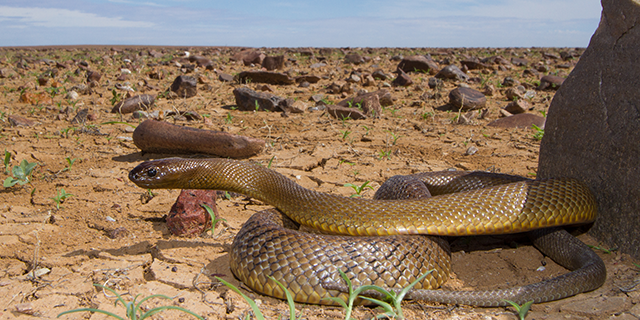Introduction
When it pertains to the remarkable world of snakes, few species capture the creativity fairly like the infant tiger snake. Understood for their distinctive pigmentation and potent venom, these snakes are an integral component of Australia's one-of-a-kind community. In this thorough post, we will look into numerous elements of infant tiger snakes, including types of Australian snakes their habits, environment, and how to safely communicate with them. Whether you're a wild animals fanatic or just interested about these animals, comprehending baby tiger snakes can assist foster a deeper appreciation for nature.
Baby Tiger Snakes: What You Required to Understand About Their Behavior and Habitat
What Are Baby Tiger Snakes?
Baby tiger serpents are juvenile forms of the highly poisonous types recognized clinically as Notechis scutatus These serpents are largely located in coastal areas of Australia, specifically in Tasmania and southern Victoria. As they expand, their pigmentation adjustments from an extra soft palette to the particular yellow and black bands that provide their name.
One notable aspect of child tiger serpents is their dimension; hatchlings usually determine around 25-30 centimeters in size. Despite their small stature, they have an unusual quantity of poison that can be detrimental to human beings if bitten.
Physical Characteristics
Tiger snakes possess a number of key physical traits:
- Coloration: The distinctive banding pattern frequently becomes more obvious as they mature. Size: Grownups can get to sizes of approximately 2 meters. Body Shape: They have a robust body that aids in swimming and terrestrial movement.
Where Do Child Tiger Snakes Live? Comprehending Their Habitat
Understanding the environment choices of infant tiger serpents is vital for both conservation initiatives and public safety. These snakes thrive in numerous settings:
- Wetlands: Marshes and swamps offer enough hunting grounds. Coastal Regions: Usually located near beaches where they can quest for prey. Woodlands: Thick plants offers cover from predators.
Geographical Distribution
Tiger snakes are mostly found along Australia's southern coastline, consisting of:

- Tasmania: Home to one of one of the most infamous populations. Victoria: Specifically in locations near water bodies.
Are Tiger Snakes Venomous? A Deep Study Their Venom
One typical inquiry occurs when talking about baby tiger snakes: "Are tiger serpents poisonous?" The response is a definite yes!
Venom Composition
The venom of tiger serpents has neurotoxins that can trigger paralysis, coagulopathy (blood clot issues), and potentially fatality if unattended. Below's what you require to recognize:
- Effects on Humans: An attack from a tiger serpent can lead to signs and symptoms like swelling, discomfort at the bite site, queasiness, and also respiratory failure.
Comparison with Other Poisonous Snakes
In contrast to various other Australian serpents such as the eastern brownish snake or king brown snake, tiger snake poison is thought about among the most powerful. However, fatalities are uncommon as a result of enhanced clinical therapies and accessibility to antivenom.
Behavioral Patterns of Baby Tiger Snakes
Understanding just how child tiger snakes act is important for those that stay in or go to areas where these reptiles are prevalent.
Nocturnal Habits
Most baby tiger serpents show nighttime actions. They tend to forage for food throughout cooler evening temperatures. This flexibility helps them avoid killers while enhancing their hunting efficiency.

Hunting Techniques
Their searching strategies include:

- Ambush Predation: Waiting stationary until target comes close. Active Foraging: Proactively relocating via vegetation or along waterways trying to find food.
First Help for Serpent Bites: What You Should Know
Despite being interesting creatures, encounters with child tiger snakes can lead to hazardous scenarios if first aid management of snake bite attacks take place. Knowing emergency treatment procedures can conserve lives.
Immediate Steps After a Bite
Remain calm; panic boosts heart rate. Immobilize the influenced limb making use of a splint or bandage. Seek immediate clinical interest-- antivenom may be necessary.Creating a Serpent Bite First Aid Kit
A well-prepared emergency treatment kit should include:
|Thing|Objective|| ------------------------------|--------------------------------------|| Compression plaster|To debilitate the limb|| Splint|Maintains broken bones or joints|| Antihistamines|Reduces allergic reactions|| Emergency situation get in touch with numbers|Quick accessibility during emergency situations|
Common Myths About Tiger Snakes Debunked
Many myths border these intriguing reptiles; let's make clear some misunderstandings frequently held by people.
Myth # 1: All Tiger Snakes Are Aggressive
While some people may display defensive habits when intimidated, not all tiger snakes screen aggression in the direction of humans unless provoked.
Myth # 2: Infant Tiger Snakes Are Less Hazardous Than Adults
This myth could not be further from the truth! Infant tiger serpents have virtually as much venom as grownups relative to their size; therefore they posture significant risks if bitten.
FAQs About Infant Tiger Snakes
What do baby tiger snakes eat?- They largely consume little mammals, birds, frogs, and fish.
- Look for slim bodies with faint banding patterns that end up being a lot more pronounced as they mature.
- Yes! Birds of victim and larger reptiles may target them.
- Typically every couple of weeks as they grow rapidly throughout their early life stages.
- While some individuals do keep them illegally without authorizations as a result of their unsafe nature; it's generally not advised given their poisonous status.
- With punctual medical treatment-- consisting of antivenom-- the survival rate is high!
Conclusion
In recap, understanding infant tiger snakes-- what they eat, where they live, bandi bandi how they act-- can equip us with valuable expertise concerning these impressive yet dangerous creatures. The importance of education surrounding emergency treatment procedures can not be overemphasized; recognizing just how to respond properly after a bite might save lives while fostering respect for our wriggling next-door neighbors within Australia's abundant biodiversity spectrum.
By valuing these snakes' duties within environments-- and recognizing potential hazards-- we promote conjunction rather than fear-based reactions towards one another's presence in nature's grand tapestry! Whether you're a devoted hiker contemplating your following adventure or just curious concerning regional wildlife encounters near home-- this guide serves as your trusted recommendation point on the enigmatic globe occupied by our pals-- the wonderful baby tiger snake!